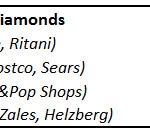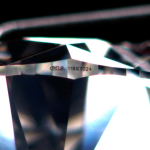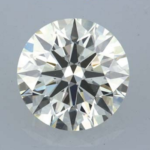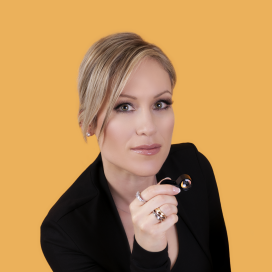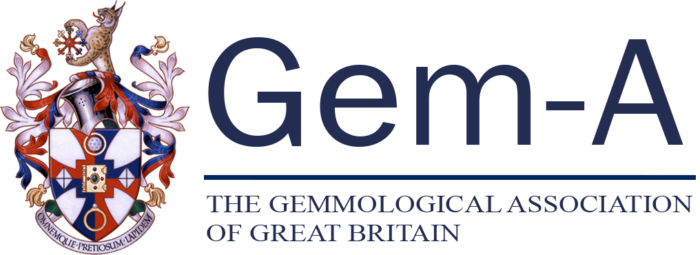Choosing the Right Ritani Diamond
Q:
Hello Liz,
I was think about getting this Ritani diamond: https://www.ritani.com/diamonds/round-diamond-1-00-Carat-G-color-GIA-certified/D-F0SM00
I want to get this setting in platinum: https://www.ritani.com/engagement-rings/double-french-set-diamond-v-engagement-ring-with-surprise-diamonds-in-platinum/4960
What do you think?
Thank you,
Chris
A:
Hello Chris,
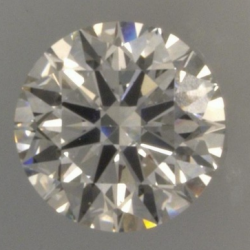 This particular Ritani diamond that you have chosen does not have any actual images or pictures accompanying it. There is no HD video for this diamond. That leaves us with the GIA report as the sole piece of information to evaluate this diamond. So, with that being said, we know that the depth is a bit deep at 63% and the average pavilion angle and crown angles are also on the larger side. Since the angles of a diamond must all fit together to equate to an ideal cut that will reflect the maximum amount of light, we can already assume that this diamond falls outside the prescribed proportion sets for an ideal cut diamond and I therefore do not recommend it.
This particular Ritani diamond that you have chosen does not have any actual images or pictures accompanying it. There is no HD video for this diamond. That leaves us with the GIA report as the sole piece of information to evaluate this diamond. So, with that being said, we know that the depth is a bit deep at 63% and the average pavilion angle and crown angles are also on the larger side. Since the angles of a diamond must all fit together to equate to an ideal cut that will reflect the maximum amount of light, we can already assume that this diamond falls outside the prescribed proportion sets for an ideal cut diamond and I therefore do not recommend it.
Instead, I recommend this 1.05ct F SI1 foir $5,736.00: https://www.ritani.com/diamonds/round-diamond-1-05-Carat-F-color-GIA-certified/D-W6SRHN
Please let me know if you have any questions!
Best,
Liz
Q:
Thanks Liz,
What proportions should I be looking for? I’m just trying to learn. 🙂
Also if it is a SI1, would it still be eye clean?
Thank you,
Chris
A:
Hello Chris,
I will list the following proportion ranges for your convenience but they are also listed on my diamond cut page for future reference. 🙂
As the American Gem Society Labs is one of the leading gem labs in the USA and they have done a significant amount of research in diamond light performance research, I have listed the current AGSL range for Ideal cut diamonds:
- Table Size: 52.4% to 57.5% of the diameter
- Depth: 58.7% to 62.3%
- Crown Angle: 33.7 to 35.8 degrees
- Pavilion Angle: 40.1 to 41.2 degrees
- Girdle Thickness: thin to slightly thick
- Facets: 58 (57 if the culet is excluded)
- Polish & Symmetry: to very good
If you take this a step further, we can further distinguish an approximate range for Super Ideal Hearts and Arrows diamonds with the following proportion ranges:
- Table Size: 53% to 58% of the diameter (54 to 57 is favorable)
- Depth: 59.5 to 62.5% (60% to 61.7% is favorable)
- Crown Angle: 33.4 to 36.4 degrees (34 – 35 degrees is favorable)
- Pavilion Angle: 40.2 to 41.2 (40.6 to 40.8 degrees is favorable)
- Lower Girdle Half: 75 – 80% (77% is favorable)
- Star Facets: 40 – 58% (45 -50% is favorable)
- Girdle Thickness: thin to slightly thick
- Facets: 58 (57 if the culet is excluded)
- Polish & Symmetry: ideal
Thus, the diamond you selected from Ritani has proportions that are outside of the recommended limits for an ideal cut diamond. Even if the diamond did fall within these tight parameters, it is still possible for a diamond to not be perfectly symmetrical in cut. This is because the values listed on a GIA report are averages. A great example of this is a recent post I wrote on Why Diamond Images Are So Important. I do not recommend purchasing a diamond from a GIA report alone.
Now, the Ritani diamond that I recommended does indeed have SI1 clarity, with the grade making inclusions of twinning wisps which are not visible in the magnified HD video. When viewing the diamond in the video, we see that it has clear and distinct dark arrow contrast that are symmetrical. This diamond is cut well, but priced low for a colorless diamond because it has strong blue fluorescence. The blue fluorescence however has no negative effect as we can clearly confirm with the magnified HD video.
Please let me know if you have any additional questions.
Kind Regards,
Liz
Hey.You Want Ideal Cut Diamonds?
You've got it.
Join ODBA's Diamond Deal Friday and get handpicked diamonds every week from me to you.
No consultation required. Subscribe now!
ODBA Recommends
You May Also Like



